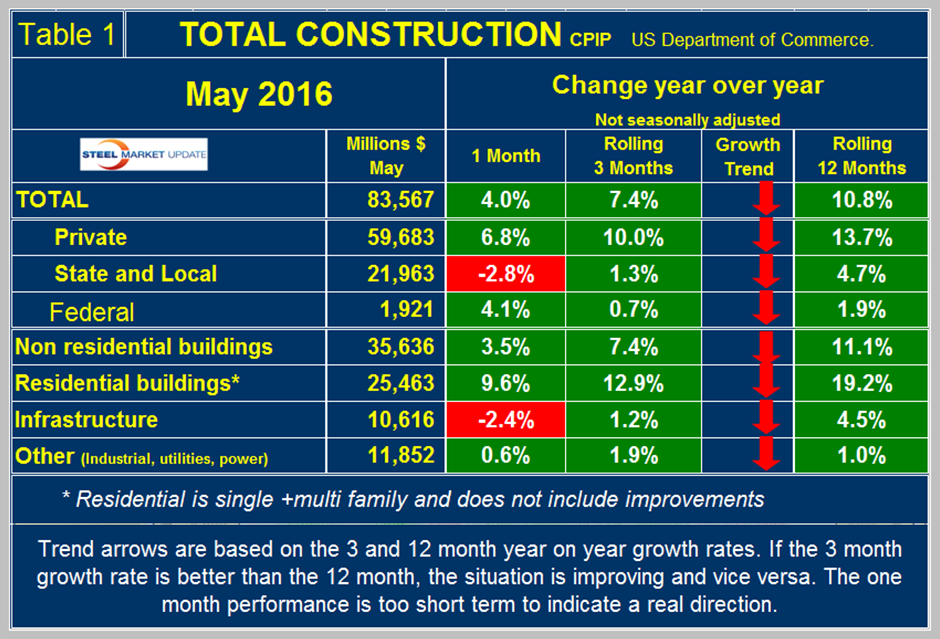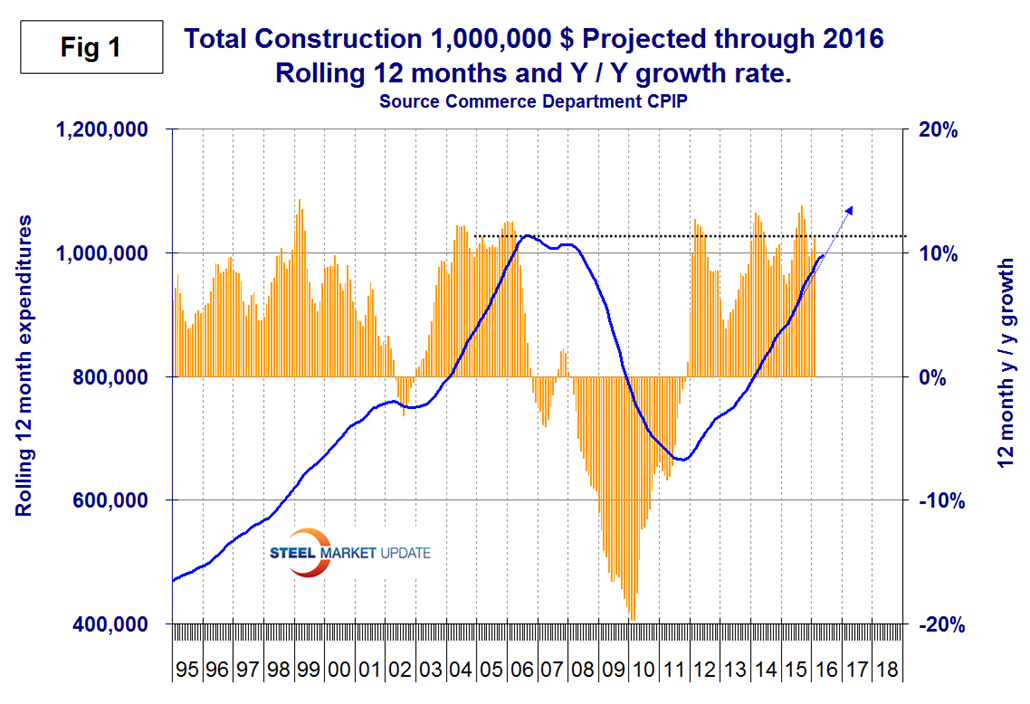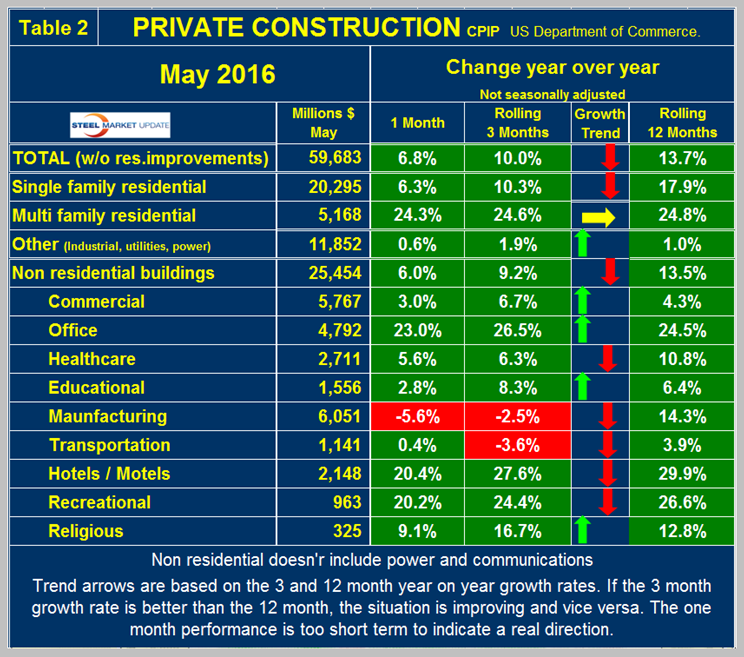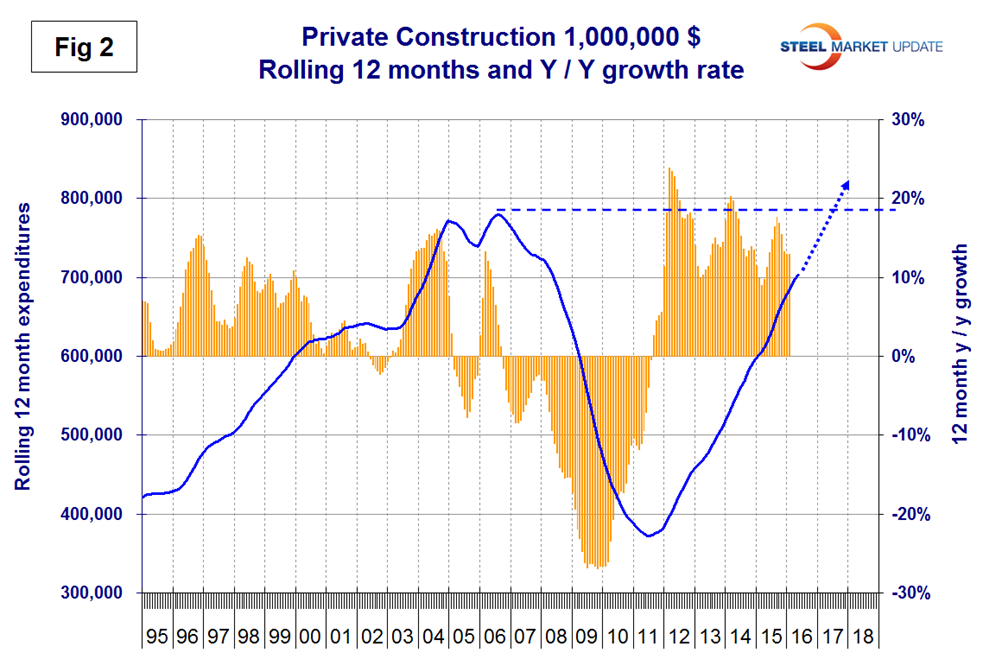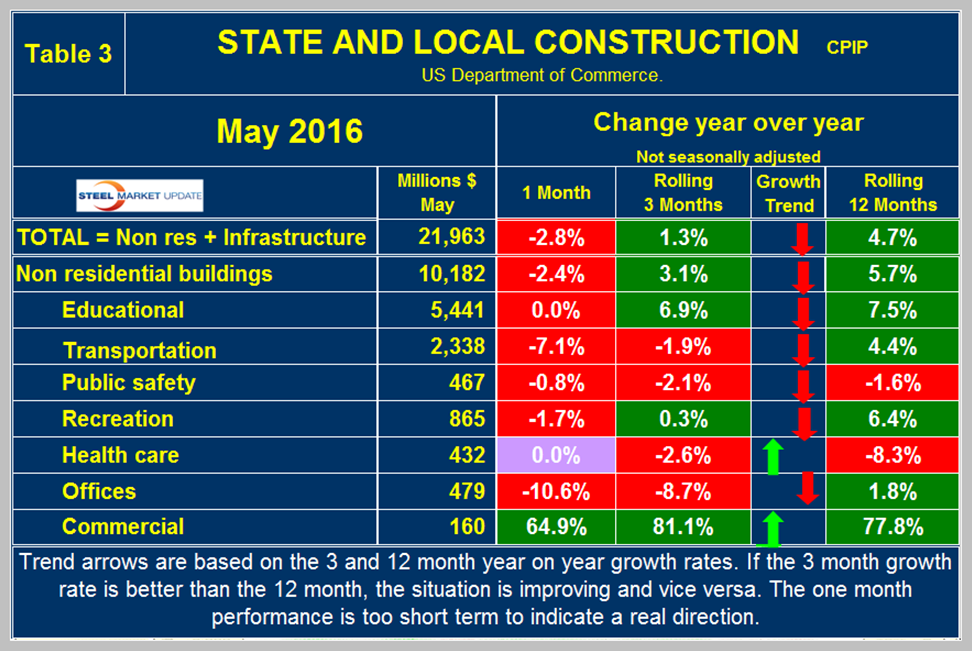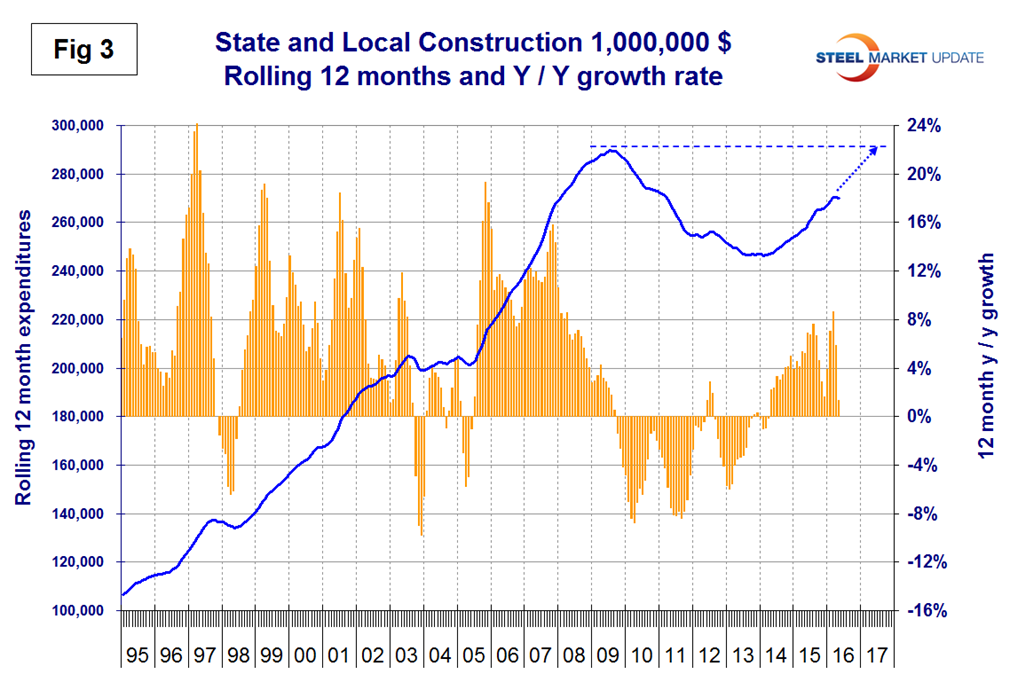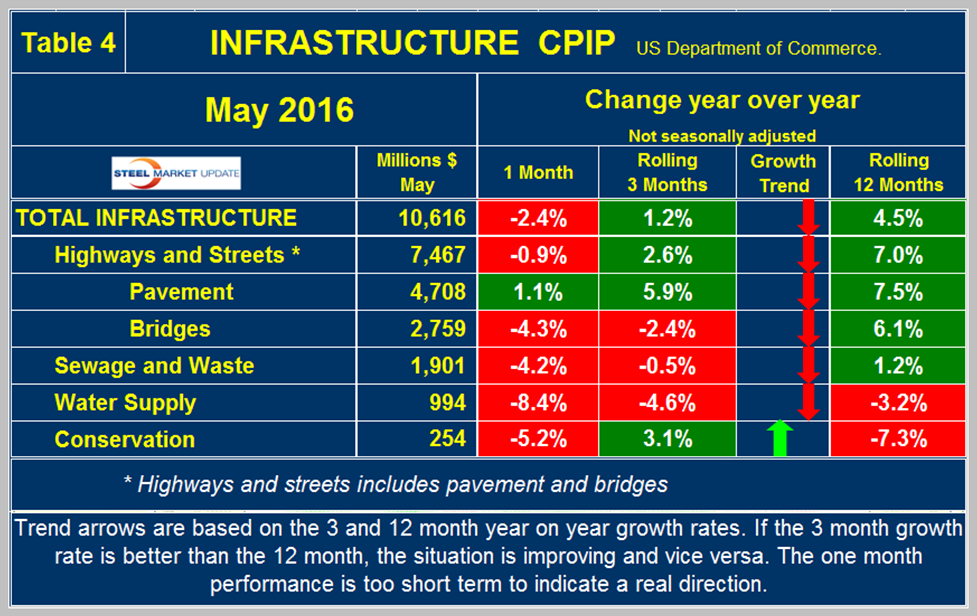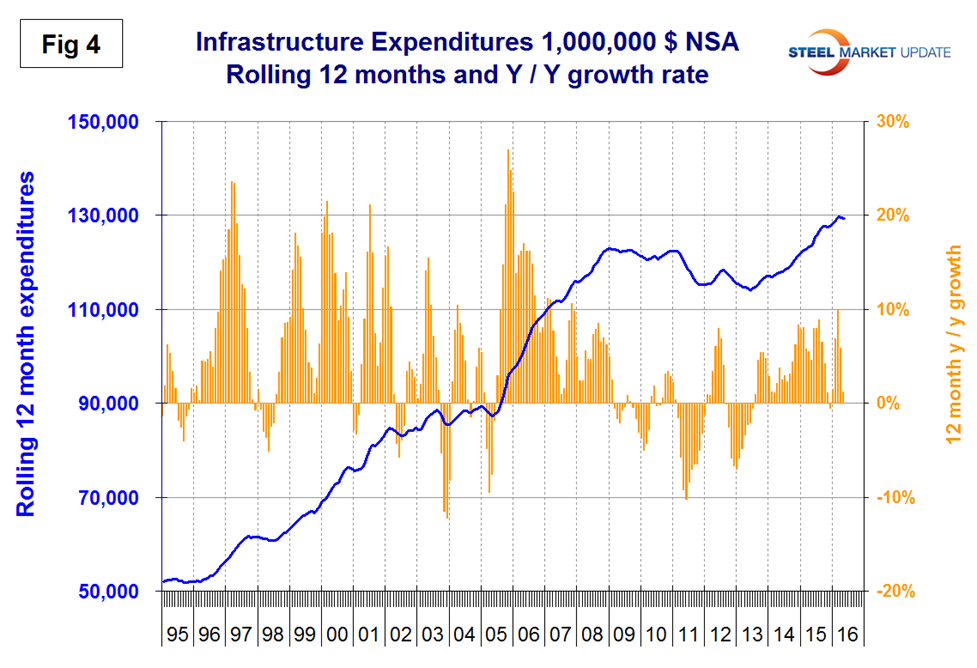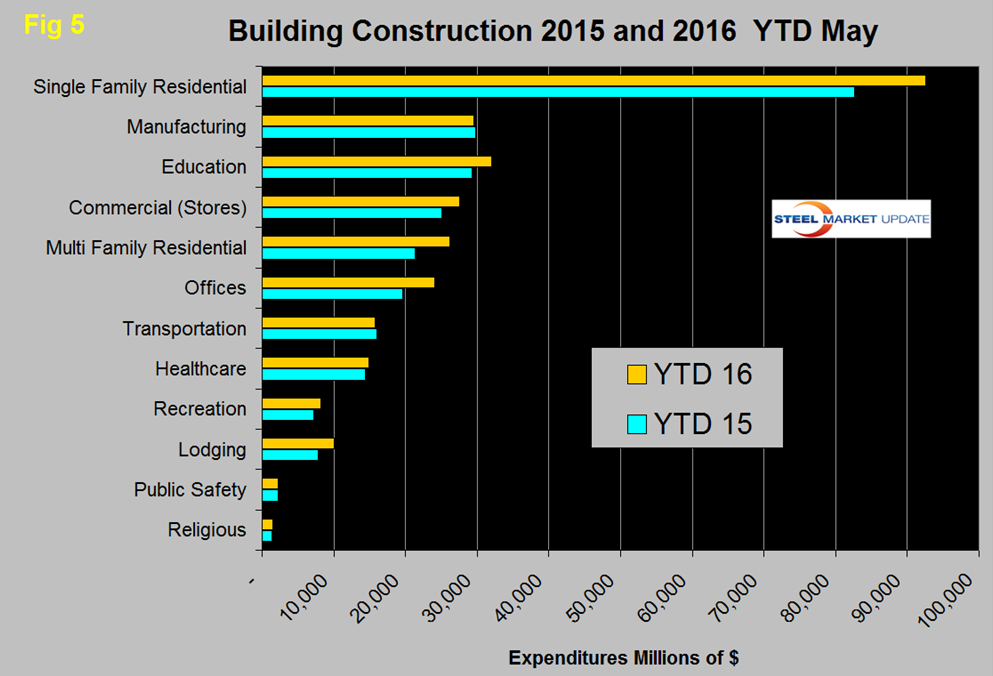Analysis

July 5, 2016
Construction Expenditures through May 2016
Written by Peter Wright
Each month the Commerce Department issues its Construction Put in Place (CPIP) data, usually on the first working day covering activity two months earlier. May data was released on Friday July 1st and included revisions back to January 2014.
![]() Construction Put in Place is based on spending work as it occurs, estimated for a given month from a sample of projects. In effect the value of a project is spread out from the project’s start to its completion. This is different from the starts data published by the Census Bureau for residential construction, by Dodge Data & Analytics and Reed Construction for non-residential and Industrial Information Resources for industrial construction. In the case of starts data the whole project is entered to the data base when ground is broken. The result is that the starts data can be very spiky which is not the case with CPIP.
Construction Put in Place is based on spending work as it occurs, estimated for a given month from a sample of projects. In effect the value of a project is spread out from the project’s start to its completion. This is different from the starts data published by the Census Bureau for residential construction, by Dodge Data & Analytics and Reed Construction for non-residential and Industrial Information Resources for industrial construction. In the case of starts data the whole project is entered to the data base when ground is broken. The result is that the starts data can be very spiky which is not the case with CPIP.
At SMU we analyze the CPIP provided by the Department of Commerce with the intent of providing a clear description of activity in this steel consuming sector. Please see the end of this report for more detail on how we perform this analysis and structure the data but in particular note that we are presenting NONE seasonally adjusted numbers. Much of what you will see in the press may differ from what we are presenting here because others are basing their comments on adjusted values. Our rational is that construction is highly seasonal, our businesses function in a seasonal world and we also don’t understand how the adjustments are made neither do we trust them.
Total Construction
Total construction grew by 7.4 percent in three months through May year over year. This was the first month of single digit growth after three consecutive months of double digit expansion. On a rolling 12 months basis construction has expanded y/y by > 10 percent for each of the last ten months. In the last twelve months construction growth has been as strong as at any time since our data stream began over twenty years ago however it is evident that growth is slowing as momentum has been negative for five of the last six months. The revisions back to January 2014 didn’t make much difference to the trends. All growth measures included below are on a three month moving average (3MMA) basis year over year which eliminates seasonality.
May expenditures were $83.567 billion which breaks down to $59.683B of private work, $21.963B of state and locally (S&L) funded work and $1.921B of federally funded (Table 1).
The red and green arrows in all four tables in this report show momentum. May on a 3MMA basis had an increase in year over year growth of 7.4 percent which was lower than the 10.8 percent growth on a rolling 12 months basis. This means that the growth rate has negative momentum but is still historically good. Total construction will reach the pre-recession level at the end of this year if the present growth rate is maintained (Figure 1).
The 7.4 percent growth of total construction y/y was led by private work up by 10.0 percent. State and locally financed work was up by 1.3 percent and Federal was up by 0.7 percent. Momentum was negative for all three finance channels. We consider four sectors within total construction. These are non-residential, residential, infrastructure and other which is a catch all and includes industrial, utilities and power. All four of these sectors had negative momentum in May. The growth rate of residential buildings was the only sector with a double digit growth rate. The growth rate of “Other” became very negative at the time of the oil price collapse but has recovered to positive growth in the last nine months. The growth rate of total construction is shown by the brown bars in Figure 1. The pre-recession peak of total construction on a rolling 12 month basis was $1,028 B in 12 months through September 2006. The low point was $665.1 B in 12 months through October 2011. The 12 month total through the latest data of May 2016 was $995.9 B. July 2015 through May 2016 were the first months to exceed $900 B since March 2009 when the recession was gaining traction.
The Associated General Contractors of America had this to say in their blog dated July 1st. Construction spending dipped in May but posted strong, broad-based gains for the first five months of 2016 compared to the same period in 2015. Association officials said the construction spending gains come amid signs that contractors are having an increasingly hard time finding qualified workers to hire. “Mild winter weather in many regions early in 2016, followed by extreme rains in some locations in May, has probably distorted monthly spending patterns but shouldn’t mask the robust widespread growth in demand for construction so far this year,” said Ken Simonson, the association’s chief economist. “It appears there will be plenty of activity in the remainder of 2016—if contractors can find the workers they need.”
Private Construction
Table 2 shows the breakdown of private expenditures into residential and non-residential and subsectors of both.
The growth rate of private construction was 10.0 percent in the last three months as shown by the brown bars in Figure 2.
The blue lines in all four graphs in this report are 12 month totals which smooths out seasonal variation. Excluding property improvements our report shows that single family residential grew at 10.3 percent and multi-family residential is still surging with a 24.6 percent growth rate. The growth of single family construction expenditures reported here is almost exactly the same as the starts data reported by the Census Bureau. (In the starts data the whole project is entered to the data base when ground is broken as described above). However multi family is very different. In this CPIP report multifamily starts grew by 24.6 percent but starts data from the Census Bureau grew at only 2.8 percent. It remains to be seen whether this difference portends a future slowdown in multifamily. Within private non-residential, all sectors except manufacturing and transportation had positive growth led by hotels/motels, offices and recreational buildings, however all but four sectors had negative momentum.
State and Local Construction
S&L work expanded by 1.3 percent in the rolling three months through May y/y with negative momentum (Table 3).
This was the lowest growth rate since April 2014. Figure 3 shows year over year growth as the brown bars. Educational buildings are by far the largest sub sector of S&L non-residential at $5.4 billion in May and on a 3MMA basis y/y grew at 6.9 percent with negative momentum.
Transportation terminals slowed to a negative 1.9 percent growth rate. All other sectors within S&L are relatively small. Recreational buildings which includes convention centers, sports arenas, theaters and miscellaneous amusements grew at 0.3 percent in the latest data with negative momentum. Public safety, which includes jails, police, courthouses and fire stations is in a slump and has contracted for 41 of the last 42 months. Table 2 shows that S&L commercial buildings grew at 81.1 percent but this is a very small volume. Comparing Figures 2 and 3 it can be seen that S&L construction did not have as severe a decline as private work during the recession and that private work bounced back faster. Private expenditures are on track to exceed the pre-recession high by mid next year but the slowdown in S&L is making such a prediction unwise.
Drilling down into the private and S&L sectors as presented in Tables 2 and 3 shows which project types should be targeted for steel sales and which should be avoided. There are also regional differences to be considered for which data is not available from the Commerce Department.
Infrastructure
Expenditures have had only one negative growth month since July 2013, but growth has slowed from a nine year high of 10.0 percent in March this year to 1.2 percent in this latest data for May. Highway and streets including pavement and bridges account for about 2/3 of total infrastructure expenditures and had positive growth every month since July 2013 but slowed to 2.8 percent in May this year. Highway pavement is the main subcomponent of highways and streets and had a 5.9 percent positive growth in three months through May. Bridge work had positive growth for each of the 12 months through April but contracted by 2.4 percent in May (Table 4).
Infrastructure expenditures were slow to respond to the recession due to the magnitude of many of these projects. Growth stopped in 2009 and 2010 but it wasn’t until 2011 that an actual contraction occurred. For most of 2015 through May 2016 infrastructure expenditures exceeded the pre-recession high (Figure 4).
It looks as though the passage in late December of the congressional bill for $305 billion to fund roads, bridges, and rail lines may not have kicked in yet due the long planning and permitting processes for such projects. The five-year infrastructure bill is the longest reauthorization of federal transportation programs that Congress has approved in more than a decade, ending an era of stopgap bills and half-measures that left the Highway Trust Fund nearly broke and frustrated local governments and business groups.
Total Building Construction Including Residential
Figure 5 compares YTD expenditures for building construction for 2015 and 2016.
Single family residential is dominant and in the first five months of 2016 totaled $92.5 billion, up from $82.7 billion in the same period last year. All building sectors except public safety, transportation and manufacturing are doing better this year than last. At the other extreme lodging (hotels and motels) were up by 27.9 percent followed by multi-family residential buildings up 22.6 percent and offices up by 22.5 percent.
Explanation: The official CPIP press report gives no appreciation of trends on a historical basis and merely compares the current month with the previous one on a seasonally adjusted basis. The data is provided as both seasonally adjusted and non-adjusted. The detail is hidden in the published tables which we at SMU track and dissect to provide a long term perspective. Our intent is to provide a rout map for those subscribers who are dependent on this industry to “Follow the money.” This is a very broad and complex subject therefore to make this monthly write up more comprehensible we are keeping the information format as consistent as possible. In our opinion the absolute value of the dollar expenditures presented are of little interest. What we are after is the magnitude of growth or contraction of the various sectors. In the SMU analysis we consider only the non-seasonally adjusted data. We eliminate seasonal effects by comparing rolling three month expenditures year over year. CPIP data also includes the category of residential improvements which we have removed from our analysis in the rational that such expenditures are minor consumers of steel.
In the four tables above we present the non-seasonally adjusted expenditures for the most recent month of data. Growth rates presented are all year over year and are the rate for the single months result, the rolling 3 months and the rolling 12 months. We ignore the single month year/year result in our write ups because these numbers can contain too much noise. The arrows indicate momentum. If the rolling 3 month growth rate is stronger than the rolling 12 months we define this as positive momentum and vice versa. In the text, when we refer to growth rate we are describing the rolling 3 months year over year rate. In Figures 1 through 4, the blue lines represent the rolling 12 month expenditures and the brown bars represent the rolling 3 month year over year growth rates.



